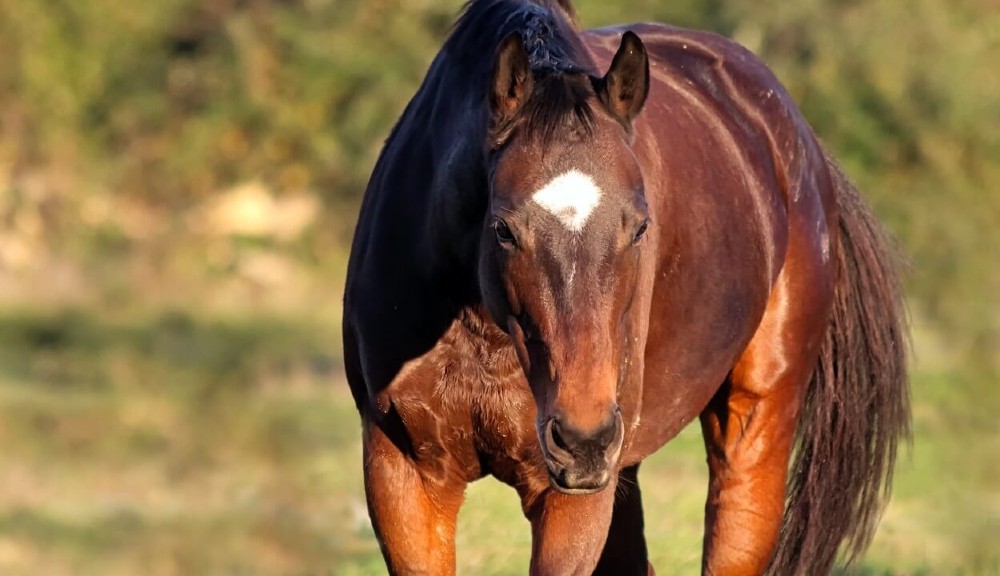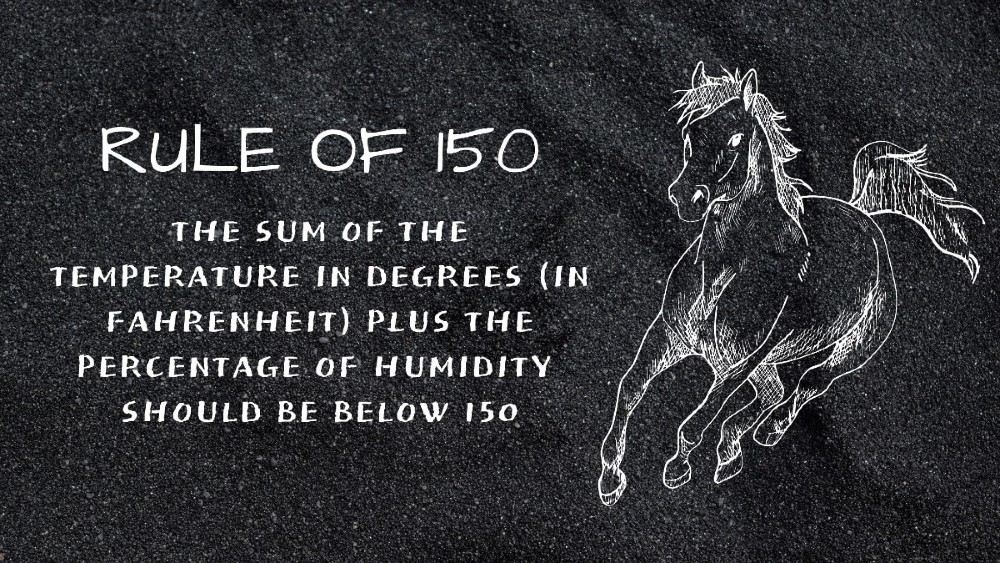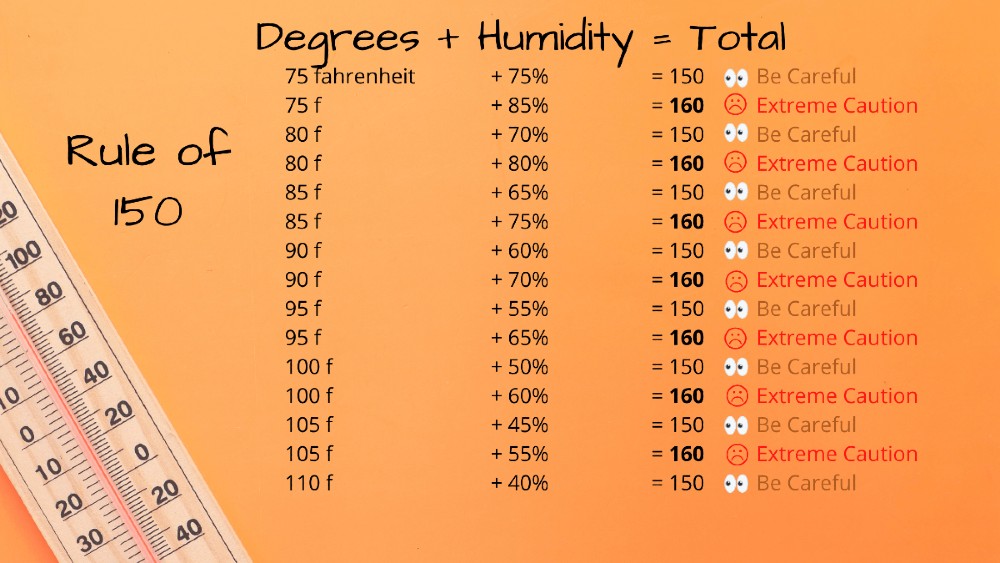A beautiful summer day is a great time to ride your horse. But it can also be a dangerous time to ride if the temperatures are too high for your horse to stay cool and comfortable. Learning about horse safety in extreme heat can make the summertime rides fun and safe for both you and your horse.
How hot can horses safely tolerate? If given enough time to acclimate to a particular high-temperature climate, horses can safely be ridden in temperatures around 100 degrees Fahrenheit (37.7 degrees Celsius). However, the more rigorous a ride or workout may be, the lower the ambient temperature a horse can tolerate.
But heat isn’t the only factor. The higher the humidity percentage, the less your horse can handle hotter temperatures. As temperatures reach the 90s and humidity exceeds 60%, it becomes challenging for your horse to stay cool. Temperatures above 100 degrees Fahrenheit become difficult when the humidity levels reach over 50% humidity.
Higher humidity slows your horse’s sweat evaporation from their skin, which is their natural cooling system. If the humidity is extremely high, a horse will not cool themselves properly through sweat evaporation. Instead, you will need to help by providing cold water showers, a cooling blanket, or ice packs on the legs and neck. Check out Is Summer or Winter More Dangerous for my Horse?
What Temperatures Can Horses Tolerate?
When a horse is active, its muscles naturally generate heat as it moves. Add this natural body heat to the outside temperature, and your horse could be very uncomfortable. If given plenty of time to acclimate to a warm climate, an idle horse with access to water and shade can tolerate temperatures above 100 degrees Fahrenheit (37.7 degrees Celsius) without needing any extra care or attention from you.
However, when you start exercising, riding, or working that horse, the higher ambient temperatures can become much more of a danger to its health and wellbeing.
If you are not comfortable in the heat, chances are your horse won’t be either. If a horse is properly acclimated to a specific climate, he can tolerate a wide range of temperatures from extreme cold to extreme heat. But if your horse breed is from the cooler temperatures of the north and has traveled to the much more hot and humid temperatures in the south for a show or event, he may need more time to adjust to the temperature change before he can be ridden or worked safely.
Like humans, horses have sweat glands under their skin throughout their bodies. As a horse sweats, there is an evaporation process that helps cool the surface of the skin and the blood vessels directly beneath the skin. This natural cooling system ensures your horses’ core body temperature stays within a safe range. When ridden, a horse can quickly work himself into a frothy white sweat or look damp in high-muscle areas such as the hindquarters, shoulders, and chest. This is normal and good, especially if there is a cool breeze and low humidity.
What Temperature is Too Hot for a Horse?
The natural body temperature of a horse at rest is around 99.5 to 101 degrees Fahrenheit (37.5 to 38.5 degrees Celsius). Once a horse starts exercising or being ridden, its body temperature can rise as the muscles start creating their own heat. Then your horse starts to sweat, and the natural cooling process begins from the evaporation of the sweat into the air.
Once a horse’s body temperature reaches 104 degrees Fahrenheit (40 degrees Celsius), it enters the heat stress range. It might be time to consider slowing down the exercise or giving your horse a chance to fully cool off on its own in the shade or by hosing your horse off with water before continuing to exercise or ride.
If the horse’s body temperature reaches 106 degrees Fahrenheit (41 degrees Celsius) or higher, the horse is dangerously close to heatstroke and must be cooled off immediately. If your horse remains at 106 degrees Fahrenheit (41 degrees Celsius) or higher for more than 15 minutes, its organs may already be starting to shut down. If not acted on immediately, serious and long-term injuries can occur, including brain damage that causes strokes, seizures, and blindness.
The outside ambient temperature itself is usually not much of a concern for horses, especially if there is a cool breeze and they have access to fresh water and plenty of shade. However, when a high temperature is mixed with high humidity, the natural cooling effect of their evaporating sweat becomes much less effective.
Horses in desert climates usually have a much easier time cooling down in the heat of the day since the air is dry and their sweat evaporates quickly. Horses in humid areas do not benefit from quick evaporation of their sweat and can become heat-stressed much easier.
When is it Too Hot to Ride a Horse?
An easy way to know if it will be too hot to ride your horse is to think of the “Rule of 150”. This straightforward math equation can give you a general idea of the comfort level your horse will experience when being ridden, exercised, or worked on hot and humid days. Add the degrees in Fahrenheit to the percentage of humidity, and if the total is more than 150, your horse may be uncomfortable during the ride.
For example, if it is 90 degrees Fahrenheit with 65% humidity, the total value of adding those two figures together would come to 155, which is slightly over the 150 comfort level range. While you can still ride your horse safely in these temperatures and humidity levels, the “Rule of 150” tells you that you might want to take it much slower than usual and give your horse plenty of time to take breaks in the shade, drink water, or perhaps wait until the temperature or humidity drops a bit so you can both enjoy your time together.
Acclimation to a certain climate is also a major factor in what temperatures you should and should not ride in. If your horse has spent its entire life in high temperatures and humidity, he may be more than ready for a midday ride. If he is more used to cooler climates, it might be safer for you and your horse if you ride during the cool mornings or evenings when the sun is less intense.
Horse shows and events also try to schedule around the temperatures for both horse and rider safety. Most shows and events won’t have anything scheduled during the hottest part of the day. This is an excellent time for you and your horse to enjoy a nice cool drink, rest in the shade, or have some fun playing with a water hose or sprinkler. The show or event will most likely continue later in the afternoon or another day when the temperatures are less extreme.
How to Care for Horses on Extremely Hot Days
Ensuring your horse is properly hydrated should be your first and highest priority on scorching days. Dehydration can cause the blood to become thicker, which in turn forces your horse’s heart to work harder to pump blood throughout the body. When this happens, fluids are absorbed from other parts of the body to keep the bloodstream flowing. Dehydration can cause gastrointestinal distress, fatigue, and muscle spasms in horses.
Excessive sweating can also lead to electrolyte imbalance. Most horse owners think only high-level endurance horses or those competing in demanding shows or events need electrolyte supplements. But the fact is, any horse that is often sweating from high temperatures or being worked and ridden in the summer can benefit from having those vital nutrients replenished. When a horse sweats, it loses vast amounts of sodium, chloride, and potassium. These vitamins are necessary for proper kidney function, neurological processes, gut health, and muscle functions.
There are a variety of ways to help your horse cope with sweltering days. You may want to use just one method or try them all and see which one works best for your equine friend. These may include:
- freezing food in ice cubes and offering them to your horse as a treat
- placing cold packs on their legs or neck
- using a cooling blanket
- providing a sprinkler or misting system for your horse to walk through or stand-in
- ensuring your barn has plenty of airflows to help with sweat evaporation
How to Tell if a Horse is Properly Hydrated
A well-hydrated horse will have a much easier time adjusting to higher temperatures than a horse that might be suffering from dehydration. An easy way to check a horse for dehydration is with the “pinch test.” You would pinch a bit of the horse’s skin between your fingers and let it go. Count how many seconds it takes for that pinched skin to smooth out. If it takes more than a couple of seconds for the skin to smooth, your horse may be dehydrated.
Another way to check hydration levels is by checking your horse’s gums. You can press your finger into the horse’s gums and see how long it takes for the color to return. You want to see moist, pink, healthy-looking gums that regain their color almost immediately when pressed with your finger. Gums that are dry, pale, or blue can signify serious health problems, including dehydration, circulation issues, and more.
How to Tell if a Horse is Suffering from Heat Stress or Heat Stroke
Signs of heat stress can start to show up when your horse’s body temperature gets to around 104 degrees Fahrenheit (40 degrees Celsius). You may start to notice your horse is not sweating as much as it was earlier in the ride. Your horse may be stumbling or acting fatigued, and you might even notice panting that lasts for several minutes even after you stop riding and give your horse a rest.
Heat Stroke is when a horse’s body temperature reaches 106 degrees Fahrenheit (41 degrees Celsius) or higher. By this point, you should already have made the call to your veterinarian, as this can quickly become an emergency. Horses that are not cooled off immediately can suffer long-term damage to the brain, major organs, and circulatory system. The easiest and quickest way to cool off a horse in this situation is by hosing him down with cold water and placing ice packs on the large veins in the neck.
Both heat stress and heat stroke signs can include fatigue, disorientation, aggressive or erratic behavior, and anxious behavior. Your horse may stumble or collapse and have difficulty getting back to its feet. Even if you manage to cool down a horse suffering from heatstroke quickly, damage may have already wreaked havoc to the kidneys, liver, or other internal organs.
How to Cool Off an Overheated Horse
Sometimes, even with all of the precautions before you go on your ride, your horse might still end up overheating. One of the best and quickest ways to cool off an overheated horse is by hosing it down with cool or cold water. By cooling the neck, shoulders, and belly area, you are instantly helping to drop the core body temperature and make your horse more comfortable.
You can scrape water from the coat and allow the rest to evaporate naturally. This provides a huge boost to your horse’s natural evaporative cooling system and can help drop his body temperature quickly to a much more comfortable level. Doing this multiple times in a row, allowing 10 or 15 minutes for the moisture to evaporate, can be a quick and effective way of cooling off an overheated horse.
Another way to help cool off your horse is by encouraging him to drink cool or cold water. A heavily exercised and overheated horse can drink up to 18 gallons (70 liters) of water per day regardless of the temperatures. If your horse seems thirsty but refuses to drink, try offering your horse a salt block to lick instead. This not only helps to replenish the sodium lost as your horse sweats, but it can also help trigger the thirst response.
Make sure your horse has plenty of ventilation while he is cooling off. Whether it’s from a natural breeze or a fan in the barn, having air movement over the dampness caused by sweat or the hosing down you did earlier is extremely important in helping your horse use its own natural evaporative cooling system.
Do Black Horses get Hotter than Other Colored Horses?
Black horses get hotter faster than other colored horses. Heat is absorbed in much higher amounts into black and dark colors, reflecting light colors. This is true for many objects, including clothing and vehicles, but the same is also true for horses. Black, dark bay and dark brown horses do seem to get hotter than their cream, buckskin, and gray counterparts in the summertime.
If your equine companion happens to have a dark coat or dark skin, be sure to give it a little more assistance in staying cool during the summer months. Being mindful of ways to keep your horse cool before and during a ride, as well as knowing how to cool off an overheated horse, can ensure you many happy days with your four-hooved friend during the summer.
Conclusion
Whether you are horseback riding for pleasure on the weekends or it’s a part of your daily life, keeping your equine companion cool and comfortable during extremely high temperatures can make a huge difference in both safety and performance. From a casual trail ride to a rigorous workout, you should now be able to notice if your horse is starting to overheat and have a variety of methods in mind that can help cool it off quickly.
My Favorite Equine Resources For Horses and Donkeys
This list contains affiliate products. Affiliate products do not cost more but helps to support BestFarmAnimals and our goal to provide farm animal owners with accurate and helpful information.
Squeaky Chicken Toy is hilarious to watch and the horses love it! It’s not super tough so keep it away from dogs.
Dewormer with Ivermectin: I use this for my horses and my goats. Duvet makes a great dewormer. I switch between the Ivermectin one and one like this one so the worms don’t get immune to it.
Manna Pro Apple Flavored Nuggets are a delicious smelling treat that my horses go crazy over.
Equinity Amino Acid Supplement for Horses makes a big difference for any horse that’s struggling with arthritis, hoof issues, or just generally. It’s great for older horses who can’t absorb all the nutrients in their food as well!
Manna Pro Weight Accelerator helps older horses gain weight and stay healthier! This was especially helpful when one of my older horses lost weight over the winter and helped her regain her weight over the summer!
Farnam Fly Control goes on the horse or donkey and will keep the flies off your sweet pet. It makes horses way more comfortable and will keep sores from getting infected as well.
Wound Kote protects sores and wounds. It acts as an antiseptic and helps wounds heal faster. It works on both my horses and goats.



